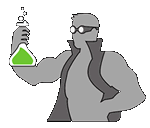Stabilizing the hips during powerful, dynamic movement is something all athletes need to do.
And strengthening these "connecting" muscles can really pay off in terms of athletic performance where force transfer is absolutely critical to getting the most power out of your lower body.
This exercise pairs simultaneous hip extension on one side with hip flexion on the other side to strengthen the muscles that must deal with these opposing forces during powerful movements such as sprinting or jumping.
To do this one, you'll need a bench, a pair of kettlebells (or one kettlebell and something to attach weight to your other leg with) and something to hang onto.
I'm using two 53 lb kettlebells in the demo.
You can also use an ankle weight or a Monkey Feet boot for the hip flexion side (you'll see).
Set a flat bench or box under a bar. I'm holding onto the chin-up bar on my rack. A Smith machine bar or pretty much anything else solid that you can hang onto for balance as you're doing the exercise will be fine.
This isn't balance training...we want to be able to use fairly heavy weight for this and that means holding onto something.
Hold a kettlebell or dumbbell in one hand, hanging down. Hold onto the bar with your other hand.

Now squat down on one leg and hook your toes through the handle of the kettlebell that's on the floor.

You'll notice that I'm leaning forward at the bottom here...that's on purpose. That forward lean creates more stretch on the glute at the bottom by creating more hip flexion. This gives the extension portion of this movement more room to run.
Now stand up, doing a single leg squat...pushing with the glutes as much as possible versus the quads (they will be involved but we're looking for more action at the hip).
Try to use your grip on the bar primarily for stabilization and balance. You will likely have a tendency to help pull yourself up, which is fine. Just try to keep it to a minimum and rely on lower body power for the movement.

As you stand up, do a knee raise with your other leg. This is hip flexion on the other side.
Bring your knee up as high as you can with a powerful movement.

This dual action of hip extension on one side and hip flexion on the other creates the opposing forces we're looking for in the hip and core area. THIS is what strengthens those muscles that transfer the force during movement.
Do your reps on side until you start to lose power in the hip flexion side (that's generally going to be the weaker side).
Then switch legs and go again on the other side.


This one does take a little bit of coordination but it's not super complicated. After a few reps, you'll be able to do both movements at the same time smoothly.
One of the limiting factors on this exercise will be TOE flexor strength. Since you're hooking your toes under the handle of the kettlebell, you'll be limited to how much weight you can hold like that.
Now, if you have a Monkey Feet boot, no problem...you won't be limited by toe flexors at all. You'll just need to actually have one, of course! I'll do a demo of this in action at some point as well.
This one is actually surprisingly challenging.
If you think about it, you're doing a single leg squat with BOTH the weights, not just the one you're holding in your hand. Even though you're using hip flexors to pull the other weight up, the squatting leg still has to move your entire body plus that weight up.
For me on this, it's like doing a single leg squat with 106 lbs. I recommend 4-6 reps on each leg for 2-4 sets. Alternate which leg you start with on each set.
If you're an athlete or would like to strengthen your hip stabilization for other reasons, this is absolutely an exercise worth trying. It's not a hypertrophy exercise...it's completely targeted to strengthening movement.
Contralateral Antagonistic Neuromuscular Activation for being 10% stronger instantly.
I explain this concept more fully in this version of the dumbbell shoulder press.
Essentially, by simultaneously working the antagonistic muscle on the other side of your body, you can actually get about 10% more nervous system drive to the primary targeted working muscle.
In this case, when you work the right glute and left hip flexor, you'll get about 10% more drive to each of those muscles during the movement. Which means you'll be about 10% stronger in it.
It's not the primary focus of this movement but it is a nice bonus!
For the upper body version of this push-pull style of training, check out the Ab Ripper.
---
Are you 40...50...60 or even 70+ years old and want to build muscle and strength like you did 20 years ago?
If you feel like you're fighting a losing battle, you're ready to discover the REAL secret to REVERSING muscle loss due to aging...
*** You need to train the body systems that SUPPORT your muscle mass, not just the muscle itself. ***
These underlying support systems diminish as you age, which is why you lose muscle as you get older no matter how hard you train... but with strategic training, these systems can be regenerated.
Share This Page...
Want More Exercises Like This?
You'll find them here...



